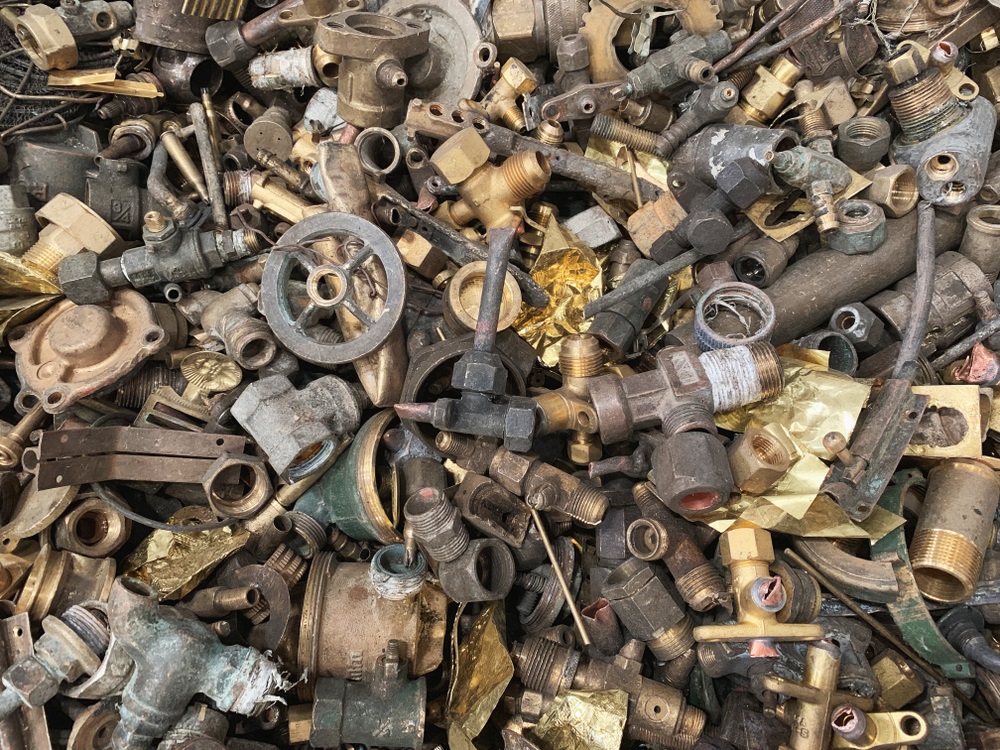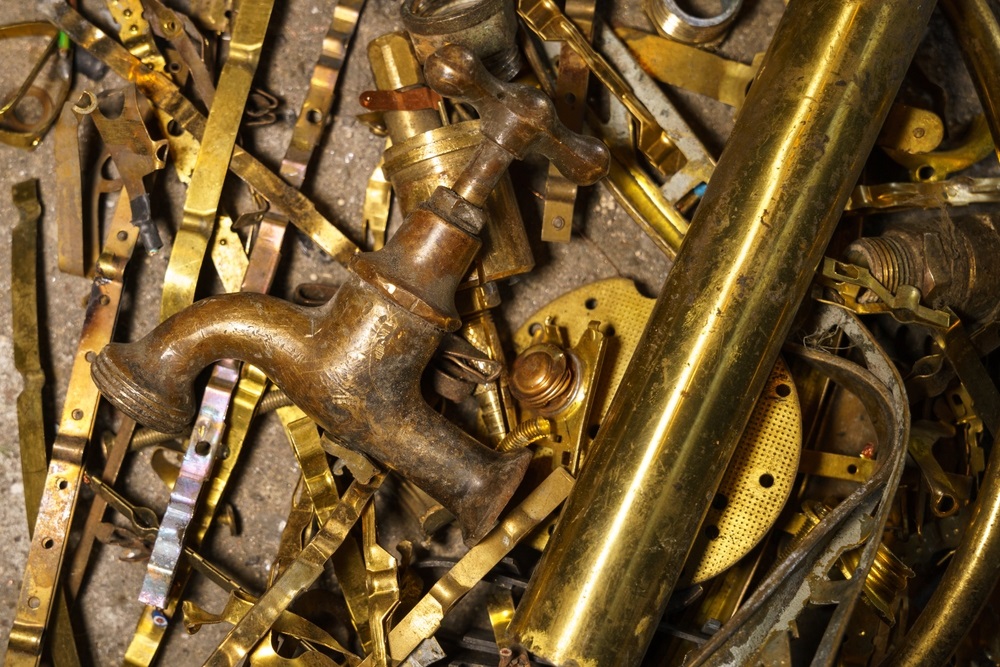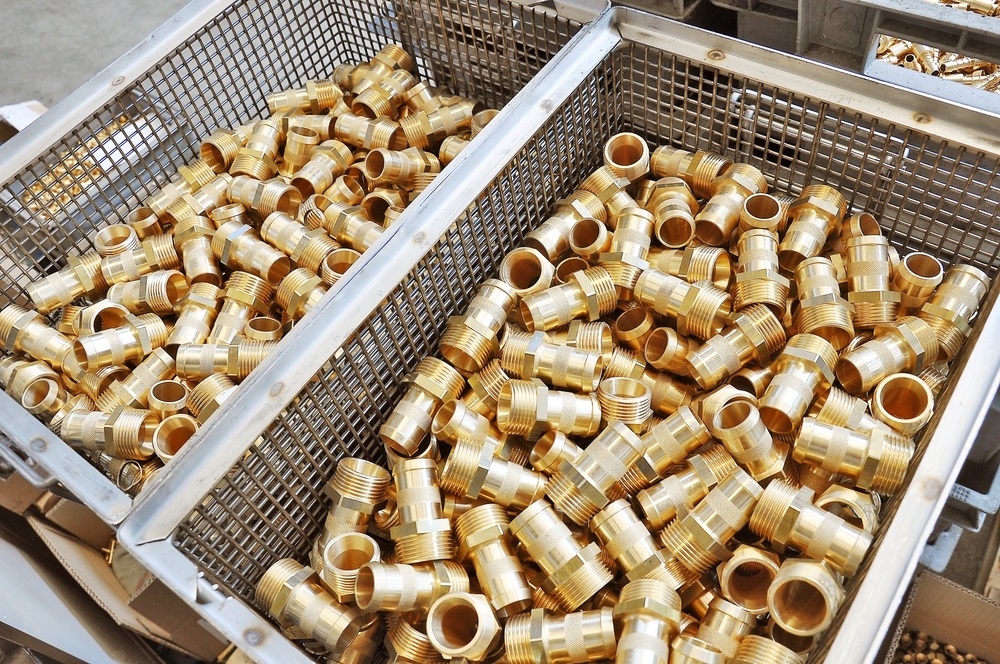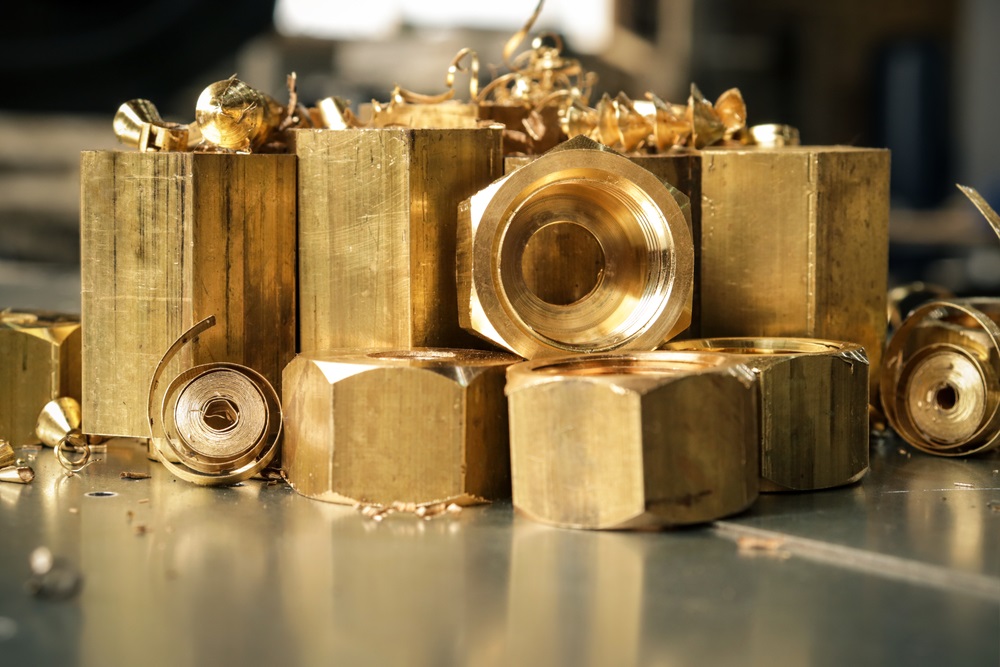10 KINDS OF COMMON BRASS TO RECYCLE TODAY

Recycling is an essential practice that helps reduce waste and conserve resources. When it comes to metals, brass is one of the most commonly recycled materials. In this article, we will explore the world of brass recycling, including what brass is, its various types, uses for brass and common items made from brass that can be recycled.
What is Brass?
Brass is an alloy composed primarily of copper and zinc, with varying proportions of other elements such as lead, tin, aluminium, nickel, and iron.
This combination gives brass its unique properties, including excellent malleability, corrosion resistance, and attractive aesthetics. Brass has been used by civilizations for centuries due to its versatility and durability.
What Is Brass Made Of?
Brass is typically made up of copper and zinc, but the exact composition can vary depending on the desired properties.
The percentage of copper in brass ranges from 55% to 95%, while zinc content can vary from 5% to 45%. Other elements are often added in smaller amounts to enhance specific characteristics.
Here’s an extensive table summarizing the composition of various brass alloys:
Brass Alloy | Copper (%) | Zinc (%) | Other Elements (%) |
Alpha Brass | 90-95 | 5-10 | – |
Cartridge Brass | 70-90 | 10-30 | – |
Naval Brass | 60-63 | 37-40 | – |
Yellow Brass | 60-70 | 30-40 | – |
Red Brass | 85-90 | 10-15 | 1-5 (tin) |
Dezincification-Resistant Brass | 80-85 | 14-20 | 1-5 (lead, iron) |
Manganese Brass | 65-80 | 30-35 | 1-5 (manganese) |
High-Leaded Brass | 60-70 | 30-40 | 1-3 (lead) |
Low-Leaded Brass | 60-70 | 30-40 | 3-4 (lead) |
White Brass | 55-70 | 30-45 | – |
What Colour Is Brass?
- What color is brass?
- Can the colour of brass vary?
Let’s answer these. Brass is an alloy that exhibits a variety of colours, which can vary depending on its composition and the specific alloying elements present. Here are some common types of brass and their corresponding colours, along with the reasons for their specific hues:
1) Red Brass
Colour: Reddish-brown.
Reason: Red brass gets its colour from its higher copper content, usually around 85-90%. The increased copper content gives it a reddish hue, which becomes more prominent when combined with a small amount of tin.
2) Yellow Brass
Colour: Vibrant yellow.
Reason: Yellow brass, also known as architectural brass or 70/30 brass, contains around 60-70% copper and 30-40% zinc. The higher zinc content contributes to its yellow colour.
3) Industrial Brass
Colour: Muted yellow-brown
Reason: Composition, processing techniques and desired properties
Industrial brass is a term used to describe brass alloys that are primarily used in industrial applications. The colour of industrial brass can vary depending on the desired properties and alloying elements incorporated. It can range from yellowish hues to reddish-brown tones.
4) White Brass
Colour: Silver-white
Reason: The higher proportion of zinc in the alloy composition imparts this distinct colour.
White brass, also known as nickel brass or German silver, exhibits a silver-white colour that closely resembles silver itself. White brass is often used as a substitute for silver due to its similar appearance.
Brass Alloy | Colour | Reason for the Specific Color |
Red Brass | Reddish-brown | Higher copper content and the addition of tin |
Yellow Brass | Vibrant yellow | Balanced ratio of copper and zinc |
Industrial Brass | Muted yellow-brown | Composition and processing techniques |
White Brass | Silver-white | Higher proportion of zinc in the alloy |
What Is Brass Used For?
Brass uses are found in a wide range of industries, thanks to its desirable properties. Here’s some common brass usage:
Brass usage has seen a significant increase in the manufacturing industry due to its excellent durability and corrosion resistance.
- Construction sector: The construction sector relies heavily on brass usage for various applications such as plumbing fixtures and decorative hardware.
- Musical instruments: Musical instrument manufacturers extensively utilize brass for its unique tonal qualities and aesthetic appeal.
- Electrical: Brass usage in electrical connectors and components ensures efficient conductivity and long-lasting performance.
- Automotive Industry: The brass uses in the automotive industry span manufacturing engine components and fittings for its reliability and heat resistance.
- Decorative Items: Brass usage in jewellery and ornamental items adds a touch of elegance and sophistication to accessories and home decor.
- Plumbing systems: Plumbing systems heavily rely on brass usage for their ability to withstand water corrosion and maintain structural integrity.
- Art & Aesthetics: The art and craft industry embraces brass usage for sculpting, casting, and creating intricate designs.
- Marine Applications: Brass usage in marine applications offers excellent resistance to saltwater corrosion, making it ideal for ship fittings and fixtures.
- Aerospace Industry: The brass uses in the aerospace industry is found in various aircraft parts and components for its lightweight yet robust characteristics.
How Much Is Brass Worth?
- Is brass expensive?
- Does the brass value based on its type and quality?
- Can the value of brass fluctuate depending on market conditions?
- What factors determine the price in the brass scrap metal market?
Some of the most frequently asked questions about brass value price and market worth.
The brass value can vary depending on international market trends, demand, and various other factors. Several factors affect the price of brass, including:
- Purity: The higher the copper content and the lower the presence of impurities, the more valuable the brass.
- Weight: Brass is priced based on its weight, usually measured in kilograms or pounds.
- Market Demand: Fluctuations in supply and demand can impact the price of brass.
- Quality: Brass with superior characteristics or specific certifications may fetch a higher price.
- Current Market Rates: The price of brass is influenced by the prevailing market rates for copper and zinc.
- Condition: Clean and properly sorted brass is more valuable than contaminated or mixed metals.
To determine the brass value and priced accurately, it is recommended to consult with a reputable brass scrap metal dealer or recycling centre. They will consider these factors and provide you with an appropriate valuation.
The brass value also fluctuates based on international market trends and demand. Here’s an overview of brass pricing considerations based on local and international markets:
International Pricing: The London Metal Exchange (LME) provides benchmark pricing for non-ferrous metals, including copper and zinc, which are essential components of brass. Brass prices often correlate with these base metal prices.
Australian Market: In the Australian market, the brass value can be influenced by factors such as local supply and demand, brass scrap metal dealer rates, and exchange rates. It’s advisable to check with local scrap metal yards or online platforms that provide real-time brass value and pricing information.
The Importance Of Brass Scrap Recycling

Brass scrap recycling is not only cash-generating but also environmentally beneficial. By recycling brass, we can reduce the need for mining new resources and minimize the environmental impact associated with extraction and processing.
Additionally, brass scrap recycling helps conserve energy, reduce greenhouse gas emissions, and decrease landfill waste. It’s a sustainable choice that benefits both the economy and the planet.
Different Types Of Brass To Recycle
Brass comes in various compositions and is classified into different types, each with unique properties. Here are three common types of brass that can contribute to sustainable brass scrap recycling practices:
1. Red Brass
Composition: Red brass, also known as gunmetal, typically consists of approximately 85% copper, 5% zinc, 5% tin, and 5% lead.
Usage: Red brass has a reddish-brown colour and is commonly used in plumbing fixtures, valves, and pump parts. It possesses excellent corrosion resistance and high tensile strength.
2. Yellow Brass
Yellow brass is the most common type of brass and contains around 60% copper and 40% zinc.
Usage: This type of brass has a yellowish appearance and is widely used in musical instruments, hardware, plumbing fittings, and decorative items. It offers good malleability and is resistant to tarnishing.
3. Industrial Brass
Industrial brass is a diverse category that encompasses various brass alloys used in industrial applications. The composition of industrial brass can vary significantly depending on the specific application.
Usage: It is commonly used in electrical connectors, automotive parts, and machinery components due to its strength, conductivity, and corrosion resistance.
Common Brass Items You Can Scrap
Brass usage is prevalent in everyday objects. Here are some examples of uses for brass and common brass items. These items can be recycled and contribute to sustainable brass scrap recycling practices.
Musical Instruments
- Trumpets
- Trombones
- Saxophones
Plumbing Fixtures
- Faucets
- Showerheads
- Valves
- Pipe fittings
Radiators
- Old radiators in homes and vehicles
Gears & Parts
- Gears
- Bearings
- Bushings
- Mechanical parts
Light Fixtures
- Chandeliers
- Lamps
- Light switches
Shell Casings
- Brass shell casings from spent ammunition
Decorative Items
- Sculptures
- Figurines
- Candle holders
- Ornaments
Hardware & Tools
- Hinges
- Knobs
- Handles
- Locks
Locks And Keys
- Old locks
- Keys
Doorknobs And Handles
- Doorknobs
- Handles
How to Identify Solid Brass Items from Brass-plated Items

It is essential to differentiate between solid brass items and brass-plated items before recycling. Here is a simple process to identify the authenticity of brass:
1st. Visual Examination
Look for signs of wear and tear or discolouration. Solid brass items tend to develop a natural patina over time, while brass-plated items may show signs of peeling or flaking.
2nd. Magnet Test
Use a magnet to determine if the item is attracted to it. Solid brass is non-magnetic, whereas brass-plated items may contain magnetic materials beneath the thin brass layer.
3rd. Weight Comparison
Solid brass items are generally heavier than brass-plated objects. Compare the weight of the item in question with a known brass item of similar size.
4th. Acid Test
Apply a small drop of diluted acid (such as vinegar) to an inconspicuous area of the item. If it reacts or corrodes, the item is likely brass-plated, as solid brass is resistant to most acids.
Identification Method | Solid Brass Items | Brass-Plated Items |
Visual Examination | natural patina over time | signs of peeling or flaking |
Magnet Test | Non-magnetic | May contain magnetic materials beneath the brass layer |
Weight Comparison | Heavier than brass-plated objects | Lighter than solid brass items |
Acid Test | Resistant to most acids | Reacts or corrodes when in contact with acid |
Differentiating Brass From Copper And Bronze
Although brass, copper, and bronze share similar characteristics, they differ in composition and appearance. Here’s how you can differentiate brass from copper and bronze:
A. Composition
Brass: Primarily composed of copper and zinc.
Copper: Consists of mostly pure copper with minimal or no alloying elements.
Bronze: An alloy of copper and tin, sometimes including other elements like aluminium or phosphorus.
B. Colour and Appearance
Brass: Brass has a yellowish or golden colour, but the shade may vary depending on the specific composition.
Copper: Copper has a distinct reddish-brown colour.
Bronze: Bronze typically has a reddish-brown appearance but can vary depending on the alloy composition.
C. Patina
Brass: Brass develops a greenish patina when exposed to air and moisture.
Copper: Copper develops a characteristic greenish patina, known as verdigris, over time.
Bronze: Bronze can develop a greenish or brownish patina, depending on the specific alloy.
Attributes | Brass | Copper | Bronze |
Magnetism | No | No | No |
Colour | Gold or Yellowish | Reddish-brown | Reddish-brown (can vary) |
Composition | Copper/Zinc | Copper | Copper/Tin |
Tarnish | Yes | Yes | Yes |
Chemical Test (HCl) | Effervescent | No reaction | Effervescent |
Patina | Greenish | Greenish (verdigris) | Greenish or brownish |
What Is Bronze Made Up Of?
Bronze is frequently confused with brass. Although they are both different from each other. So, the question remains, “What is bronze made up of?”
Bronze is another popular copper-based alloy, primarily composed of copper and tin. The addition of tin gives bronze-enhanced strength, corrosion resistance, and a unique reddish-brown colour.
Bronze has been used throughout history for sculptures, tools, and weapons due to its durability and unique properties.
Bronze Alloy | Copper (%) | Tin (%) | Other Elements (%) |
Phosphor Bronze | 80-95 | 0.1-0.35 | 0.01-0.5 (phosphorus) |
Aluminum Bronze | 60-90 | 5-12 | 0.5-12 (aluminium) |
Silicon Bronze | 96-99 | 0.5-3 | 0.1-2 (silicon) |
Leaded Bronze | 80-90 | 3-10 | 2-7 (lead) |
Manganese Bronze | 60-90 | 3-40 | 0.2-4 (manganese) |
Recycle Brass for a Sustainable Future

Recycling brass is not only financially rewarding but also environmentally responsible. By identifying and collecting various types of brass items, such as red brass, yellow brass, and industrial brass, you can contribute to the circular economy and reduce the demand for new resources.
Differentiating solid brass from brass-plated items and distinguishing brass from copper and bronze are crucial skills for effective recycling. So, gather your brass items and recycle them today to play your part in building a greener world.
Protect The Environment & Earn Some Extra Cash
If you have brass scrap items that you’re ready to recycle, bring them to our recycling centre. We accept all kinds of brass, including red brass, yellow brass, and industrial brass. We provide market-competent brass value, ensuring that you receive fair compensation for your recycled brass items.
Recycle your brass scrap today!
Join West Coast Metal in creating a greener future.
West Coast Metal Accept All Types of Brass for Recycling!
FAQs
1. What is the best brass to scrap?
When it comes to scrapping brass, the best type of brass to consider depends on the specific application and the current market prices for different brass alloys.
Red Brass: 85-90% copper. Red brass fetches a higher price due to its higher copper content.
Yellow Brass: (60-70% copper) (30-40% zinc). Yellow brass is typically accepted and valued by scrap yards.
2. What is red brass used for?
Red brass is most frequently used in water metres and other plumbing fittings like faucet valves. Additionally, various musical instruments and jewellery are made from it.
3. What is the special quality of brass?
Brass is a low-friction, soft, non-ferrous metal. Brass can easily be cut, sawed, and drilled. Brass is a fantastic option for components where corrosion resistance is crucial.
4. What brass is used for pipes?
Red brass is the most durable of all metals for plumbing systems and commercial water pipe usage.
5. Does brass turn green?
The Patina Effect: Brass will become blue-green when exposed to air and water. The patina effect on brass is somewhat less blue and more green.
6. Is brass magnetic?
No Brass isn’t magnetic.
7. What are the 5 uses of brass?
- Aesthetic uses: Brass is widely employed for its bright gold-like appearance in various decorative applications.
- Low friction applications: Brass reduce friction, making it suitable for use in locks, gears, bearings, ammunition, and valves.
- Plumbing uses: Brass is used in plumbing due to its durability, corrosion resistance, and ease of forming into various shapes.
- Electrical uses: Brass has excellent conductivity and resistance to corrosion, making it suitable for connectors, terminals, and other electrical components.
Acoustic applications: Brass has unique acoustic properties that contribute to resonant sound production. It is favoured in musical instruments such as horns and bells etc.

